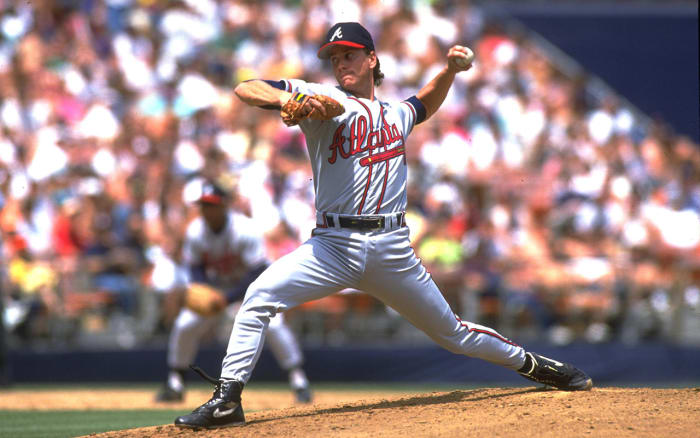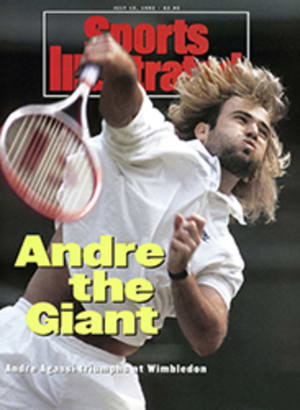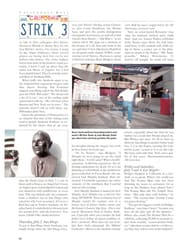A Gripping Tale
The scouting report from the National Hockey League is still kicking around on the fringes of Tom Glavine's life. A reporter in Toronto somehow obtained it from the NHL office and gave a copy to a reporter from Atlanta, who gave a copy to a reporter from somewhere, who gave a copy to.... Anyhow, the scouting report has ended up here.
Name: Thomas Glavine
Birth date: Mar. 25,1966
Height: 6'
Weight: 180 pounds
Skate size: 9½
The blanks on the first two pages are filled with the studied printing of a high school student's hand. Medical information. Hockey background. Honors received. Hopes and aspirations. On the third page, typed, are the succinct musings of an unnamed evaluator of talent: "Good skating ability...long stride with good balance...good acceleration...excellent scorer, smart around net...has several moves and can finish off...excellent slap and wrist shots with a quick release...tough and durable, will not be intimidated...excellent competitor." The final ranking, stamped at the top of the third page, is No. 56 out of 240 or so draft-age hockey players.
Eight years have passed since this report was written. All the other players in that draft, the draft of 1984, have either lived up to the anonymous assessments on their reports or faded to jobs in the workaday world. This is the one report that remains open. The last prospect. How good can this kid, this center-ice man, this lefthanded shooter from Billerica, Mass., ever be? No one knows.
"I never was too keen about Tommy playing pro hockey," says the prospect's father, Fred, owner of a small construction business in Billerica. "Hockey, it's a long haul. He probably could have made it, but to really succeed? It seems to me there are a number of players who are expendable every year. There's tremendous turnover."
"The decision never was whether to play hockey," says the kid himself, now grown and successful. "The decision was whether to go to college. I had a full hockey scholarship to the University of Lowell. That was a big thing. Four years of college for free."
The most telling question in that entire scouting report was this: "Other sports in which you participate and your hobbies?" The one-word answer, written in the teenage hand, was "Baseball."
No one will ever know how well the most successful pitcher in baseball today would have done in hockey. The last prospect will remain a prospect, forever.
"The question I'm always asked again and again is what I learned from hockey to bring to baseball," says Glavine, the 26-year-old lefthander for the Atlanta Braves. "I've thought about it a lot. The answer, I think, is nothing. The games are so different, requiring such different skills. What's the same? I suppose I could say mental toughness or aggressiveness, something like that might come from hockey. But otherwise, nothing."
The idea that Glavine would ever play that other game—he was drafted in the fourth round by the Los Angeles Kings—has faded with each succeeding baseball season, going and going and ultimately gone. Those hard bodychecks in the corner? That pell-mell rush to the net? That collision of pads and sticks and people? Gone. He is a practitioner of this quieter game, this game of rhythm and style and chessboard intelligence, soaring again as the ace in the Braves' rotation.
Hockey? At week's end Glavine had a 12-3 record in this baseball season and a 2.63 ERA. He was heading along the same path that last season made him a starter in the All-Star Game, a 20-game winner and the easy choice for the National League Cy Young Award. His salary this year is $2.925 million. Hockey is a sport of his past.
If anything, Glavine's style as a pitcher is the opposite of the style a hockey player needs. An imaginative mind can see Roger Clemens, the 1991 Cy Young winner in the American League, lacing up a pair of skates and dropping his gloves at center ice to fight the biggest and baddest goon on the other side. Clemens, the man who wears a mouth guard to stop himself from grinding his teeth while he pitches, is all fire and spirit and malevolence. Glavine? An imaginative mind can see him in an office, a solver of corporate problems, an idea and detail man in a suit and tie.
He goes about his business with precision, not angst. He deceives. He fools. One pitch sets up another pitch, and another, and another. His dominant pitch, for goodness' sake, is the changeup. The changeup? There is no hockey equivalent to the changeup.
"He's got command of four pitches: the fastball, curveball, slider and change," Atlanta pitching coach Leo Mazzone says. "He has great control, and he can change speeds as well as anyone in this game. I was telling him the other day that when I was growing up, my idol as a pitcher was Whitey Ford. Tommy is the Whitey Ford of today."
Glavine's mental approach—unflappable is the word used most often to describe it—is the foundation for his success, the foundation, in fact, for his survival. Selected by the Braves in the second round of the 1984 draft and signed despite the scholarship offer from Lowell, Glavine has followed a fast and bumpy road to where he is now. If he didn't have such no-nonsense control of his mind, he probably wouldn't have any mind left at all. In the majors by the time he was 21, suffering with a 9-21 career record by the time he was 22, playing with a succession of struggling Atlanta teams, he has passed tests that might have sent many young pitchers to early career changes.
"Tommy's never let anything bother him," his mother, Millie, says. "Not even as a kid. I think our whole family's like that. We just don't let things bother us. We're not the type of people who get frustrated at a traffic jam."
"He's had to be mature," says Fred. "He's one of those kids who was always playing each level of sports at the earliest age. He was just an athlete, good enough so the older kids would let him play. He was always the youngest."
The two-sport business made life simple. There never was that crush of specialization, of year-round devotion to a single game. When baseball was done, the equipment went into the closet. When hockey was done, the equipment went into the closet. Not until the Braves called did one set of equipment come out to stay. The signing came a few days after the 1984 state championship baseball game, Billerica High against Brockton High. Glavine pitched the first nine innings and then, with the score tied 1-1, moved to centerfield. In the 11th he made a throw to nail a Brockton runner at the plate. In the 13th he singled to lead off the inning and scored the winning run. "Of all the things he did in high school, the one that's probably remembered best is that throw from center," Fred says. "He got the kid by about 15 feet."
A few weeks later he was in Bradenton, Fla., in a rookie league, beginning the upward trip. And the ascent was rapid. Glavine quickly moved up to Double A ball in Greenville, S.C., and by the end of the 1987 season, he was in Atlanta. The following season he finished 7-17 on a 54-106 team. He was pitching some good games but getting hurt by big innings. A walk would lead to another walk, and then, suddenly, the count would be 2-0 on the next batter and Glavine would be trying to force a fastball over the plate. Not good. He realized he had to cut out those buzz-saw innings. He also realized he needed another pitch, an off-speed pitch to set up his other pitches.
He tried a split-fingered fastball that sometimes worked and sometimes didn't. He tried a pitch called the four-seam circle changeup, thrown with the index finger and thumb in a little circle against the side of the ball and the middle and ring fingers running across two seams. It really didn't work, either.
In spring training of 1989, Glavine was standing in the outfield during batting practice. A ball rolled toward him. He bent, picked it up...and somehow his fingers landed differently on the ball. The middle and ring fingers were along the seams. The circle on the side was exaggerated, the tip of the index finger on top of the thumbnail. Glavine threw the ball into the infield. Voila! A career was born.
"Throwing that way just seemed natural to me," he says. "I don't know why, but from that first throw the pitch was natural. I started throwing it that day."
The key to the changeup is being able to throw it with the same arm speed that a fastball is thrown but with reduced velocity on the ball—not dramatically reduced, but a speed at which the ball reaches the plate just late enough to foul up a normal swing at an anticipated fastball. This was the pitch, the two-seam circle change, that Glavine now had. He went 14-8 in 1989, slumped a bit to 10-12 in '90, when he forgot the lessons of the change, and then went back to relying heavily on it as he rolled to a 20-11 record last year. He estimates that he throws the pitch as many as 40 times a game now, often on 3 and 2 or 3 and 1, when other pitchers never think about it. The circle change has made the rest of his repertoire work.
"If I hadn't found that pitch, picked up the ball that way...I don't know," Glavine says. "Maybe I would have found some other pitch. I don't know. I'm just glad I found it."
On the good nights, when everything is working, he is almost unhittable. You see him in a game like the one he had last Friday night in Atlanta against the Cubs and he is pulling strings as if he were working the Muppets. A 3-0 five-hitter on 107 pitches. A no-hitter couldn't have been much more impressive.
Even when he is struggling—one pitch not working, maybe two—he survives. The attitude. The battler. He uses that same approach with his hitting and is doing so well at the plate (.271 as of Sunday) that manager Bobby Cox sometimes sacrifices runners to second in front of him.
Is there anything else? Well, he is getting married in November. He has bought and decorated a new, four-bedroom house outside Atlanta. And at the end of this season, his fifth full year in the majors, the Braves either must sign him to one of those long-term, high-money deals or sign him for one year and risk losing him as a free agent after the '93 season.
Anything else?
"I played hockey," Glavine says. "In January. With the Boston Bruins."
The day was arranged by his agent, Bob Woolf. The aftershock of winning the Cy Young—the banquets, the interviews, the attention—had begun to be a burden. The hockey was designed to be a relief. On a weekday morning Glavine skated with the Bruins during a workout at Boston Garden.
In high school he played against Tom Barrasso and Kevin Stevens, who recently starred for the Stanley Cup champion Pittsburgh Penguins. Glavine also played against a few of the present Bruins. He was named, in his senior year, as the outstanding Boston-area high school player. The award was presented at the Garden. Still, when he arrived for the practice, he was nervous. More nervous than he had been in any of his big baseball games.
"I hadn't skated with equipment in seven years," he says. "Do you know how much equipment has been developed in seven years? I was afraid I was going to put something on the wrong way or in the wrong place."
The rest was easier. He skated in the drills. He scrimmaged. He said his hands felt fine, though his legs did not always go where he wanted them to go. His father laughed in the stands.
"I remember Tommy went to some baseball tryout camp at the end of the summer before his senior year in high school," Fred says. "He pitched, and the scout said he liked what he saw. He asked when he could see Tommy pitch again. Tommy told him not until spring, when baseball season started again. The equipment was going into the closet after the camp. He was starting hockey that night. The scout couldn't believe it."
Ah, but not this time. It was the skates that went back into the closet. Glavine returned to Atlanta in the afternoon. No hockey. No. The last prospect will remain a prospect, forever.
PHOTO
MANNY RUBIO
At 12-3 Glavine again has the look of a Cy Young winner.
PHOTO
SOLOMON
[See caption above.]
PHOTO
CHUCK SOLOMON
Although he's no longer a hockey player, Glavine can still hurt an opponent with his stick.
PHOTO
STEVE BABINEAU
Glavine, with Peter Douris (left) and Brent Ashton, was a Bruin for a Day last January.


